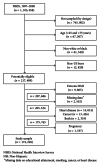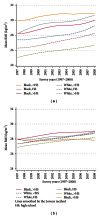Black-white disparities in overweight and obesity trends by educational attainment in the United States, 1997-2008
- PMID: 23691282
- PMCID: PMC3649192
- DOI: 10.1155/2013/140743
Black-white disparities in overweight and obesity trends by educational attainment in the United States, 1997-2008
Abstract
Background: Few studies have examined racial and educational disparities in recent population-based trends.
Methods: We analyzed data of a nationally representative sample of 174,228 US-born adults in the National Health Interview Survey from 1997 to 2008. We determined mean BMI trends by educational attainment and race and black-white prevalence ratios (PRs) for overweight/obesity (BMI > 25 kg/m(2)) using adjusted Poisson regression with robust variance.
Results: From 1997 to 2008, BMI increased by ≥1 kg/m(2) in all race-sex groups, and appeared to increase faster among whites. Blacks with greater than a high school education (GHSE) had a consistently higher BMI over time than whites in both women (28.3 ± 0.14 to 29.7 ± 0.18 kg/m(2) versus 25.8 ± 0.58 to 26.5 ± 0.08 kg/m(2)) and men (28.1 ± 0.17 kg/m(2) to 29.0 ± 0.20 versus 27.1 ± 0.04 kg/m(2) to 28.1 ± 0.06 kg/m(2)). For participants of all educational attainment levels, age-adjusted overweight/obesity was greater by 44% (95% CI: 1.42-1.46) in black versus white women and 2% (1.01-1.04) in men. Among those with GHSE, overweight/obesity prevalence was greater (PR: 1.52; 1.49-1.55) in black versus white women, but greater (1.07; 1.05-1.09) in men.
Conclusions: BMI increased steadily in all race-sex and education groups from 1997 to 2008, and blacks (particularly women) had a consistently higher BMI than their white counterparts. Overweight/obesity trends and racial disparities were more prominent among individuals with higher education levels, compared to their counterparts with lower education levels.
Figures
References
-
- Flegal KM, Carroll MD, Kit BK, Ogden CL. Prevalence of obesity and trends in the distribution of body mass index among US adults, 1999–2010. The Journal of the American Medical Association. 2012;307(5):491–497. - PubMed
-
- Ogden CL, Lamb MM, Carroll MD, Flegal KM. Obesity and socioeconomic status in adults: United States, 2005–2008. NCHS Data Brief. 2010;(50):1–8. - PubMed
-
- Ogden CL, Carroll MD, Curtin LR, McDowell MA, Tabak CJ, Flegal KM. Prevalence of overweight and obesity in the United States, 1999–2004. Journal of the American Medical Association. 2006;295(13):1549–1555. - PubMed
-
- Mirowsky J, Ross CE. Education, Social Status and Health. New York, NY, USA: Aldine de Gruyter; 2003.
-
- Zhang Q, Wang Y. Trends in the association between obesity and socioeconomic status in U.S. adults: 1971 to 2000. Obesity Research. 2004;12(10):1622–1632. - PubMed
Publication types
MeSH terms
Grants and funding
LinkOut - more resources
Full Text Sources
Other Literature Sources
Medical
Research Materials




